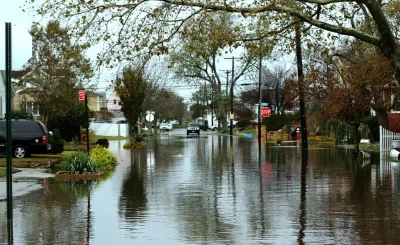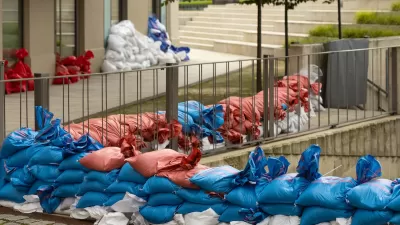Researchers from the University of Maryland and Texas A&M surveyed stormwater officials and synthesized the results. Their conclusion: "Rainwater is taking its toll on metropolitan America"

Slate staff writer Henry Grabar reports on a new study released on the threat posed by urban flooding:
It’s an anthropocene disaster, a manmade problem whose harms are decoupled from the Federal Emergency Management Agency’s floodplain maps, and from the risk awareness and preparation that goes along with that official warning. Many homeowners affected by flooding never thought they’d have to worry about it.
A new report by researchers at the University of Maryland and Texas A&M tries to assess the damage. “The Growing Threat of Urban Flooding,” released on Wednesday, surveys more than 300 stormwater officials and synthesizes the surprisingly scant body of knowledge. Rainwater is taking its toll on metropolitan America—but how do we measure it?
According to National Weather Service data, freshwater flood losses in the United States amount to nearly $8 billion a year over the past three decades—as if the damage from a very bad hurricane were spread throughout the country. Even during tropical cyclones, however, two in three flood insurance claims relate to freshwater flooding, not storm surge. Some flooding comes from swollen rivers or occurs on low-lying properties. But a surprisingly large degree of rainfall damage, based on local case studies, appears to be determined by manmade landscapes of asphalt, concrete, and iron. After scanning reports from local NWS field offices, the authors believe that the nation experienced some 3,600 urban flooding events in the past 25 years—about one every two to three days.
FULL STORY: How We Built Our Way Into an Urban Flooding Epidemic

Manufactured Crisis: Losing the Nation’s Largest Source of Unsubsidized Affordable Housing
Manufactured housing communities have long been an affordable housing option for millions of people living in the U.S., but that affordability is disappearing rapidly. How did we get here?

Americans May Be Stuck — But Why?
Americans are moving a lot less than they once did, and that is a problem. While Yoni Applebaum, in his highly-publicized article Stuck, gets the reasons badly wrong, it's still important to ask: why are we moving so much less than before?

Using Old Oil and Gas Wells for Green Energy Storage
Penn State researchers have found that repurposing abandoned oil and gas wells for geothermal-assisted compressed-air energy storage can boost efficiency, reduce environmental risks, and support clean energy and job transitions.

Updating LA’s Tree Rules Could Bring More Shade to Underserved Neighborhoods
A new USC study finds that relaxing Los Angeles’ outdated tree planting guidelines could significantly expand urban tree canopy and reduce shade disparities in lower-income neighborhoods, though infrastructure investments are also needed.

California's Canal Solar Projects Aim to Conserve Resources and Expand Clean Energy
California’s Project Nexus has begun generating electricity from solar panels installed over irrigation canals, with researchers and state agencies exploring statewide expansion to conserve water and boost clean energy production.

HHS Staff Cuts Gut Energy Assistance Program
The full staff of a federal program that distributes heating and cooling assistance for low-income families was laid off, jeopardizing the program’s operations.
Urban Design for Planners 1: Software Tools
This six-course series explores essential urban design concepts using open source software and equips planners with the tools they need to participate fully in the urban design process.
Planning for Universal Design
Learn the tools for implementing Universal Design in planning regulations.
Heyer Gruel & Associates PA
City of Moreno Valley
Institute for Housing and Urban Development Studies (IHS)
City of Grandview
Harvard GSD Executive Education
Salt Lake City
NYU Wagner Graduate School of Public Service
City of Cambridge, Maryland




























